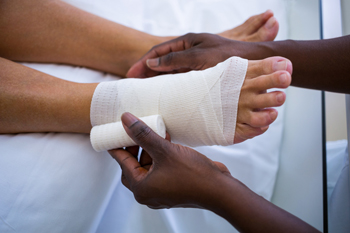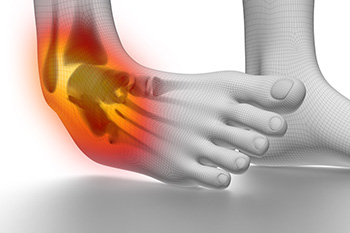Items filtered by date: April 2024
Treatment of Foot Problems in Seniors

As we age, our feet undergo various changes, often leading to discomfort and mobility issues. Treatment for common foot ailments among seniors varies, depending on the condition. Bunions may require shoe modifications, custom orthotics, medication, or surgery from a podiatrist. Hammertoe deformities may necessitate changes in footwear or in some cases surgery. Toenail problems, including ingrown nails and infections, require professional attention to prevent complications, with podiatrists offering specialized care and treatment options. Seniors with diabetes must prioritize foot health and regular podiatric evaluations to prevent serious complications, such as foot ulcers or gangrene. Plantar fasciitis treatment ranges from conservative measures, such as exercises, to surgery for effective relief. Arch problems, whether flat feet or high arches, generally necessitate a non-surgical approach along with expert guidance to manage discomfort and prevent further complications. For help with any of the many foot conditions common among seniors, it is suggested that you schedule an appointment with a podiatrist for a thorough foot exam, diagnosis, and treatment options.
Proper foot care is something many older adults forget to consider. If you have any concerns about your feet and ankles, contact Dr. John P. Beaupied from Palos Podiatry. Our doctor can provide the care you need to keep you pain-free and on your feet.
The Elderly and Their Feet
As we age we start to notice many changes in our body, but the elder population may not notice them right away. Medical conditions may prevent the elderly to take notice of their foot health right away. Poor vision is a lead contributor to not taking action for the elderly.
Common Conditions
- Neuropathy – can reduce feeling in the feet and can hide many life-threatening medical conditions.
- Reduced flexibility – prevents the ability of proper toenail trimming, and foot cleaning. If left untreated, it may lead to further medical issues.
- Foot sores – amongst the older population can be serious before they are discovered. Some of the problematic conditions they may face are:
- Gouging toenails affecting nearby toe
- Shoes that don’t fit properly
- Pressure sores
- Loss of circulation in legs & feet
- Edema & swelling of feet and ankles
Susceptible Infections
Diabetes and poor circulation can cause general loss of sensitivity over the years, turning a simple cut into a serious issue.
If you have any questions please feel free to contact our office located in Palos Heights, IL . We offer the newest diagnostic and treatment technologies for all your foot and ankle needs.
Athlete’s Foot Types and Risk Factors

Athlete's foot, medically termed tinea pedis, is a fungal infection that appears in various forms, each with distinct characteristics and associated risks. Among these, interdigital infection stands out as the most prevalent, affecting the skin between the toes and causing redness, scaling, and persistent itching. Moccasin infection is found on the sole of the foot, often masquerading as eczema due to its dry, cracked appearance. Vesicular infection results in blisters filled with pus that can rupture into open sores, heightening the risk of secondary bacterial infections. Meanwhile, ulcerative infection presents the most discomfort, with painful, oozing sores between the toes, significantly increasing susceptibility to further complications. These variations stem from exposure to dermatophytes, which are fungi thriving in warm, moist environments. Athlete’s foot infections commonly spread in communal spaces such as locker rooms, swimming pools, and shared footwear. Risk factors for contracting athlete's foot include compromised immune function, genetic predisposition, and prolonged periods of wearing tight, non-breathable shoes. If you have a problematic case of athlete’s foot, it is suggested that you schedule an appointment with a podiatrist for advanced treatment options.
Athlete’s foot is an inconvenient condition that can be easily reduced with the proper treatment. If you have any concerns about your feet and ankles, contact Dr. John P. Beaupied from Palos Podiatry. Our doctor will treat your foot and ankle needs.
Athlete’s Foot: The Sole Story
Athlete's foot, also known as tinea pedis, can be an extremely contagious foot infection. It is commonly contracted in public changing areas and bathrooms, dormitory style living quarters, around locker rooms and public swimming pools, or anywhere your feet often come into contact with other people.
Solutions to Combat Athlete’s Foot
- Hydrate your feet by using lotion
- Exfoliate
- Buff off nails
- Use of anti-fungal products
- Examine your feet and visit your doctor if any suspicious blisters or cuts develop
Athlete’s foot can cause many irritating symptoms such as dry and flaking skin, itching, and redness. Some more severe symptoms can include bleeding and cracked skin, intense itching and burning, and even pain when walking. In the worst cases, Athlete’s foot can cause blistering as well. Speak to your podiatrist for a better understanding of the different causes of Athlete’s foot, as well as help in determining which treatment options are best for you.
If you have any questions please feel free to contact our office located in Palos Heights, IL . We offer the newest diagnostic and treatment technologies for all your foot and ankle needs.
Treating Diabetic Foot Wounds

Treating diabetic foot wounds requires a comprehensive approach focused on promoting healing and preventing further complications. It begins with identifying and addressing the factors that can contribute to the wound, such as wearing proper footwear and avoiding further injury. Keeping the wound clean and protected with specialized dressings is essential to create an optimal environment for healing. Regular removal of dead tissue and calluses helps prevent infections and allows new tissue to grow. Managing bacteria surrounding the wound site is especially vital, along with ensuring good blood flow to the wound. This may involve medications or procedures to improve circulation. Off-loading techniques, like using cushions or specialized shoes, help reduce pressure on the foot wound, allowing it to heal more effectively. A podiatrist can offer personalized care and guidance throughout the diabetic wound treatment process. If you have developed a diabetic foot wound, it is suggested that you schedule an appointment with a podiatrist for correct management tips.
Wound care is an important part in dealing with diabetes. If you have diabetes and a foot wound or would like more information about wound care for diabetics, consult with Dr. John P. Beaupied from Palos Podiatry. Our doctor will assess your condition and provide you with quality foot and ankle treatment.
What Is Wound Care?
Wound care is the practice of taking proper care of a wound. This can range from the smallest to the largest of wounds. While everyone can benefit from proper wound care, it is much more important for diabetics. Diabetics often suffer from poor blood circulation which causes wounds to heal much slower than they would in a non-diabetic.
What Is the Importance of Wound Care?
While it may not seem apparent with small ulcers on the foot, for diabetics, any size ulcer can become infected. Diabetics often also suffer from neuropathy, or nerve loss. This means they might not even feel when they have an ulcer on their foot. If the wound becomes severely infected, amputation may be necessary. Therefore, it is of the upmost importance to properly care for any and all foot wounds.
How to Care for Wounds
The best way to care for foot wounds is to prevent them. For diabetics, this means daily inspections of the feet for any signs of abnormalities or ulcers. It is also recommended to see a podiatrist several times a year for a foot inspection. If you do have an ulcer, run the wound under water to clear dirt from the wound; then apply antibiotic ointment to the wound and cover with a bandage. Bandages should be changed daily and keeping pressure off the wound is smart. It is advised to see a podiatrist, who can keep an eye on it.
If you have any questions, please feel free to contact our office located in Palos Heights, IL . We offer the newest diagnostic and treatment technologies for all your foot care needs.
Risk Factors for Lateral Ankle Sprains

Lateral ankle sprains can happen to anyone as the result of a sudden movement, such as stepping off a curb and landing the wrong way. Ankle sprains are particularly common among athletes who engage in sudden stops and starts, jumping, or sideways movements. The majority of sprained ankles happen when the outer, or lateral, ligaments are stretched too much. Factors such as gender, height, and foot anatomy can contribute to vulnerability, as do previous injuries and improper footwear choices. Women wearing high heels, for instance, may be at higher risk of ankle sprains. A podiatrist can evaluate the severity of the sprain, identify underlying risk factors, and devise a personalized treatment plan for you. This foot doctor addresses both intrinsic and extrinsic factors of an ankle sprain. Treatment and a full recovery can help to minimize the risk of future ankle sprains. If you have sprained an ankle, it is suggested that you schedule an appointment with a podiatrist.
Although ankle sprains are common, they aren’t always minor injuries. If you need your ankle injury looked at, contact Dr. John P. Beaupied from Palos Podiatry. Our doctor can provide the care you need to keep you pain-free and on your feet.
How Does an Ankle Sprain Occur?
Ankle sprains are the result of a tear in the ligaments within the ankle. These injuries may happen when you make a rapid shifting movement while your foot is planted. A less common way to sprain your ankle is when your ankle rolls inward while your foot turns outward.
What Are the Symptoms?
- Pain at the sight of the tear
- Bruising/Swelling
- Ankle area is tender to touch
- In severe cases, may hear/feel something tear
- Skin discoloration
Preventing a Sprain
- Wearing appropriate shoes for the occasion
- Stretching before exercises and sports
- Knowing your limits
Treatment of a Sprain
In many cases, the RICE method (Rest, Ice, Compression, and Elevate) is used to treat ankle sprains. However, you should see a podiatrist to see which treatment option would work best with your injury. In severe cases, surgery may be required.
It is important to ask your doctor about rehab options after you receive treatment for your injury. Stretching, strength training, and balance exercises may help the ankle heal while also preventing further injury.
If you have any questions, please feel free to contact our office located in Palos Heights, IL . We offer the newest diagnostic and treatment technologies for all your foot care needs.
Exploring Hammertoe Surgery

Patients considering hammertoe surgery should be aware of potential risks and complications associated with the procedure. These include post-operative pain, swelling, and the risk of bone spur recurrence, particularly if they were a contributing factor to the hammertoe. Other complications from hammertoe surgery can include difficulty with toe mobility and altered gait, along with the possibility of nerve damage that leads to pain or numbness. As with any surgery, infection at the surgical site is another concern. Following post-operative care instructions and attending follow-up appointments with a podiatrist are vital steps in minimizing the risk of complications. To find out whether hammertoe surgery is right for you, it is suggested that you schedule an appointment with a podiatrist who can help you to make an informed decision.
Hammertoes can be a painful condition to live with. For more information, contact Dr. John P. Beaupied of Palos Podiatry. Our doctor will answer any of your foot- and ankle-related questions.
Hammertoe
Hammertoe is a foot deformity that occurs due to an imbalance in the muscles, tendons, or ligaments that normally hold the toe straight. It can be caused by the type of shoes you wear, your foot structure, trauma, and certain disease processes.
Symptoms
- Painful and/or difficult toe movement
- Swelling
- Joint stiffness
- Calluses/Corns
- Physical deformity
Risk Factors
- Age – The risk of hammertoe increases with age
- Sex – Women are more likely to have hammertoe compared to men
- Toe Length – You are more likely to develop hammertoe if your second toe is longer than your big toe
- Certain Diseases – Arthritis and diabetes may make you more likely to develop hammertoe
Treatment
If you have hammertoe, you should change into a more comfortable shoe that provides enough room for your toes. Exercises such as picking up marbles may strengthen and stretch your toe muscles. Nevertheless, it is important to seek assistance from a podiatrist in order to determine the severity of your hammertoe and see which treatment option will work best for you.
If you have any questions, please feel free to contact our office located in Palos Heights, IL . We offer the newest diagnostic and treatment technologies for all your foot care needs.



